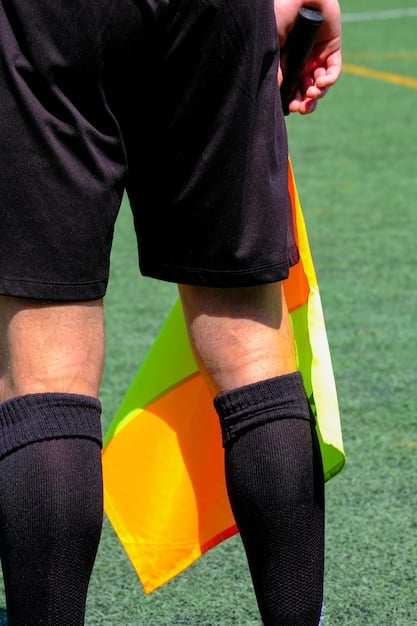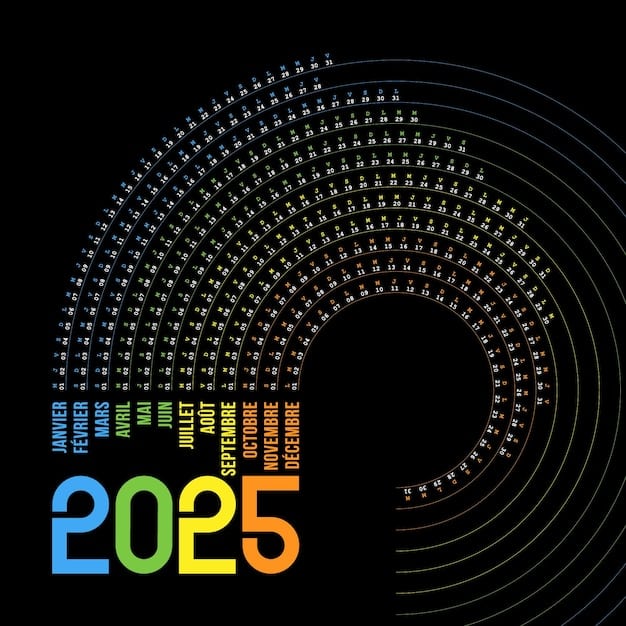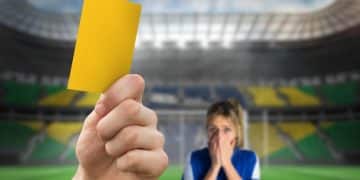FIFA’s Anti-Doping Regulations: US Player Compliance in 2025

Navigating FIFA’s Anti-Doping Regulations: What US Players Need to Know to Stay Compliant in 2025 is crucial. This comprehensive guide details the updated rules, testing protocols, prohibited substances, and compliance strategies essential for American footballers to avoid sanctions and uphold sportsmanship.
For professional and amateur footballers alike, understanding what’s expected on the pitch extends beyond tactical prowess; it encompasses a rigorous commitment to fair play, especially regarding anti-doping. As we approach 2025, American players must be acutely aware of FIFA’s Anti-Doping Regulations: What US Players Need to Know to Stay Compliant in 2025 to protect their careers and the integrity of the sport.
Understanding the Foundation: FIFA’s Anti-Doping Commitment
FIFA, as the global governing body of football, maintains a steadfast commitment to fighting doping to ensure fair competition and protect player health. This commitment is enshrined in a comprehensive framework of regulations that align closely with the World Anti-Doping Agency (WADA) Code, serving as the international standard for anti-doping.
The core principle driving FIFA’s anti-doping efforts is “Clean Sport.” This philosophy emphasizes that every athlete has the right to participate in sport free from doping. For US players, this means understanding not just the letter of the law but also the spirit behind it, recognizing their role in upholding the integrity of the game.
The WADA Code and FIFA’s Regulations
The WADA Code is the global anti-doping rulebook, harmonizing anti-doping policies across all sports and countries. FIFA’s regulations are meticulously crafted to incorporate and expand upon the WADA Code’s provisions, adapting them specifically for the nuances of football. This integration ensures a consistent approach to drug testing, prohibited substances, and sanctions worldwide.
- Harmonization: FIFA’s rules mirror WADA’s, creating a unified global standard.
- Player Rights: Regulations also safeguard player rights throughout the testing process.
- Education Focus: Emphasis on preventative education alongside enforcement.
Why Compliance Matters for US Players
For US players, non-compliance carries severe consequences that can impact individual careers and team dynamics. A single violation, even if unintentional, can lead to lengthy suspensions, financial penalties, and a damaged reputation. Beyond personal repercussions, doping undermines the competitive balance and trust in football.
Staying compliant is not merely about avoiding punishment; it’s about contributing to an ethical sporting environment. It requires proactive engagement with the regulations, consistent communication with medical staff, and a deep understanding of what constitutes a violation.
In essence, FIFA’s anti-doping commitment is a cornerstone of global football integrity. For US players, grasping these foundational elements is the first critical step toward ensuring compliance in 2025 and beyond, fostering a clean and competitive environment for the sport they love.
Key Updates to FIFA’s Anti-Doping Regulations for 2025
As the landscape of anti-doping evolves, FIFA periodically updates its regulations to address new challenges, incorporate scientific advancements, and refine existing protocols. For 2025, several key updates are projected, directly influencing how US players must navigate their anti-doping responsibilities. These changes are designed to enhance effectiveness and ensure fairness.
Staying ahead of these modifications is paramount, as ignorance of the rules is never an acceptable defense. Players, coaches, and medical teams must proactively seek out and understand these updates to maintain compliance.
The Evolving Prohibited List
The Prohibited List, issued annually by WADA, is the most dynamic component of anti-doping regulations. For 2025, there may be additions or reclassifications of substances and methods based on new research into performance enhancement and health risks. It’s crucial for US players to consult the latest list regularly.
Common updates often include new pharmaceutical compounds, novel masking agents, or clarifications around specific medical treatments. Players must communicate any medication or supplement use with team medical staff to cross-reference against the current Prohibited List. This vigilance can prevent inadvertent violations.
Enhanced Testing Methodologies
Technological advancements consistently improve doping detection methods. For 2025, FIFA may implement enhanced testing protocols, such as more sophisticated analytical techniques for blood and urine samples, or an increased focus on the Athlete Biological Passport (ABP).
- ABP Expansion: The ABP tracks individual biological variables over time, identifying deviations indicative of doping.
- Out-of-Competition Testing: Expect continued emphasis on unpredictable, out-of-competition testing, requiring players to maintain accurate whereabouts information.
- Sample Storage and Re-analysis: Longer storage periods for samples mean they can be re-analyzed with newer techniques years later.
Focus on Supplements and TUEs
A significant area of concern remains the use of dietary supplements. Many supplements are not regulated to the same stringent standards as pharmaceuticals and can be contaminated with prohibited substances. While no specific 2025 changes are anticipated regarding how supplements are viewed, there will be heightened awareness and educational campaigns.
Additionally, the Therapeutic Use Exemption (TUE) process, which allows athletes to use otherwise prohibited substances for medical conditions, may see refined procedural requirements. US players needing TUEs should ensure their medical documentation is impeccable and submitted well in advance, following the precise guidelines.
Understanding these projected updates for 2025 is not just an advantage but a necessity. Proactivity in learning and adapting to these changes will be key for US players to navigate the anti-doping landscape successfully and ensure their careers remain unblemished.

Prohibited Substances and Methods: What US Players Must Avoid
The Prohibited List is the cornerstone of anti-doping regulations, detailing substances and methods that are banned in sport. For US players, a thorough understanding of this list is non-negotiable. It categorizes substances based on their potential for performance enhancement, health risks, and whether they violate the spirit of sport.
Unintentional doping is a common yet avoidable reason for violations. This often stems from a lack of awareness about what ingredients common medications or supplements contain. Vigilance and education are the best defenses.
Categories of Prohibited Substances
The Prohibited List is divided into several main categories, each addressing different types of performance enhancement or masking agents. Players should familiarize themselves with these classifications:
Non-Specified Substances: These are substances that carry a higher risk of being used for intentional doping and typically result in longer sanctions. Examples often include anabolic agents and peptide hormones. Even trace amounts can lead to severe penalties due to their potent effects.
Specified Substances: While still prohibited, these substances are considered at higher risk of unintentional doping due to their presence in common medications or contaminants. Examples might include certain stimulants found in cold medicines or some diuretics. While sanctions can still be significant, the athlete may be able to argue diminished fault if they can prove how it entered their system unintentionally.
- Anabolic Agents: Steroids that build muscle and strength.
- Peptide Hormones: Growth hormones and similar substances.
- Beta-2 Agonists: Often found in asthma medications, but restricted.
- Masking Agents: Substances that hide the presence of other prohibited substances.
Prohibited Methods
Beyond specific substances, certain methods of enhancing performance or manipulating samples are also strictly forbidden. These methods are often sophisticated and aim to circumvent testing procedures.
Blood Manipulation: Any method that increases oxygen delivery, such as blood transfusions (autologous or homologous) or artificially enhancing the production of red blood cells (e.g., EPO use), is prohibited. These methods give an unfair advantage in endurance sports like football.
Gene Doping: The non-therapeutic use of cells, genes, genetic elements, or modulation of gene expression to enhance athletic performance is strictly prohibited. This cutting-edge form of doping represents a future challenge that regulations are already addressing.
Chemical and Physical Manipulation: Tampering or attempting to tamper with samples collected during doping control is a severe violation. This includes actions that alter the integrity and validity of samples collected in doping control, such as urine substitution or alteration.
For US players, the message is clear: when in doubt, check. Always consult team medical staff, official anti-doping resources, or the WADA Prohibited List directly before consuming any substance, whether prescription, over-the-counter, or supplementary. Your career depends on it.
The Doping Control Process: What to Expect as a US Player
Understanding the doping control process is fundamental for every US player subject to FIFA’s anti-doping regulations. From notification to sample analysis, knowing each step demystifies the procedure and ensures players can cooperate effectively while safeguarding their rights. This process is designed to be rigorous, fair, and confidential.
Being selected for doping control can happen at any time – during competition, at training, or even at home. Preparedness is key to a smooth and compliant experience.
Notification and Sample Collection
Once selected for doping control, a Doping Control Officer (DCO) will notify the player. The notification includes their authority to test and the player’s obligation to comply. The player must then report to the doping control station immediately, or within a specified time frame for justifiable delays (e.g., press conference, medical treatment).
At the station, the player will select a collection vessel and provide a urine sample under direct observation to ensure its integrity. Blood samples may also be requested. After providing the sample, the player will divide it into A and B bottles, seal them, and verify the unique code. This split sample approach allows for re-analysis if a positive result occurs.
- Identification: Player must present valid ID.
- Observation: Sample collection is observed by an officer of the same gender.
- Documentation: All steps are meticulously documented, and the player signs off.
Laboratory Analysis and Results Management
Once collected, samples are sent to WADA-accredited laboratories for analysis. These laboratories conduct sophisticated tests to detect prohibited substances and methods on the Prohibited List. Each sample is assigned a unique number to ensure anonymity and prevent identification of the player during initial analysis.
If a sample (A Sample) tests positive for a prohibited substance or method, the anti-doping organization (ADO) responsible for the test initiates results management. The player is notified of the Adverse Analytical Finding (AAF) and has the right to request the analysis of their B Sample. If the B Sample confirms the A Sample’s finding, a potential anti-doping rule violation (ADRV) is declared.
Hearings and Sanctions
Following an ADRV, the player is afforded the opportunity for a fair hearing. This hearing allows the player to present their case, explain how the substance entered their system, and challenge the findings. Legal representation is highly advisable at this stage.
Sanctions for anti-doping violations vary depending on the substance, the athlete’s degree of fault, and whether it’s a first offense. They can range from a warning to a multi-year ban from all sanctioned sports, including football. Loss of medals, titles, and prize money are also common consequences. The transparency and strictness of this process emphasize the importance of compliance for US players.
Preparing for doping control means understanding these steps, maintaining accurate whereabouts information, and always being ready to provide a sample. For US players, this readiness is a testament to their commitment to fair play and a clean sport.
Therapeutic Use Exemptions (TUEs): Navigating Medical Needs
In certain circumstances, a US player may have a legitimate medical condition that requires the use of a prohibited substance or method. In such cases, the anti-doping rules provide a pathway for the player to obtain a Therapeutic Use Exemption (TUE). A TUE allows an athlete to use a prohibited substance or method without committing an anti-doping rule violation, provided strict criteria are met.
The TUE process is rigorous and designed to ensure that the exemption is only granted when medically necessary, and it does not confer any additional performance-enhancing advantage beyond treating the medical condition.
When a TUE is Necessary
A TUE is required when a player needs a medication or treatment that contains a substance on the Prohibited List for a diagnosed medical condition. Common examples include using inhaled beta-2 agonists for asthma, insulin for diabetes, or specific hormones for documented deficiencies. However, not all medical conditions automatically qualify for a TUE.
The core criteria for granting a TUE are laid out by WADA and adopted by FIFA:
- Diagnosed Medical Condition: The player must have a clearly diagnosed medical condition.
- No Alternative: There must be no reasonable permitted alternative treatment.
- No Performance Enhancement: The use of the substance/method must not provide any additional performance enhancement beyond regaining normal health.
- Urgency: The need for the substance/method must not be a consequence of prior use of a prohibited substance or method.
The TUE Application Process
The TUE application process is meticulous and time-sensitive. US players should initiate the process well in advance of needing the medication, particularly if it’s for a chronic condition or an upcoming competition. The application typically requires detailed medical documentation, including physician statements, diagnostic test results, and treatment plans.
The application is submitted to the relevant anti-doping organization (e.g., FIFA, USADA, or a National Anti-Doping Organization), which then forwards it to an independent TUE Committee (TUEC). The TUEC, comprised of medical experts, reviews the application against the WADA criteria and makes a determination.
Key Considerations for US Players
For US players, several key considerations are crucial when navigating TUEs. Firstly, always consult with your team doctor or an anti-doping expert as soon as a potential need for a TUE arises. They can guide you through the specific requirements and ensure all necessary documentation is prepared correctly.
Secondly, keep meticulous records of all medical treatments and prescriptions. This documentation is invaluable if you ever need to apply for a TUE or explain a positive test result. Finally, be aware that a TUE granted by one anti-doping organization may not be automatically recognized by another, especially for international competitions. Always verify the recognition requirements with FIFA or the event organizer.
Properly managing TUEs is a critical aspect of compliance for US players. It allows athletes to prioritize their health while remaining fully committed to the principles of clean sport, ensuring their legitimate medical needs are met without compromising fair play.
Whereabouts Requirements: Maintaining Accountability
A critical component of FIFA’s anti-doping program, aligned with WADA’s standards, is the “Whereabouts” requirement. This regulation ensures that players can be located for out-of-competition doping tests, which are essential for catching athletes who may try to dope between competitions. For US players, especially those in the Registered Testing Pool (RTP), strict adherence to whereabouts rules is mandatory.
Failure to provide accurate and timely whereabouts information can result in an “Filing Failure” or “Missed Test,” both of which count as anti-doping rule violations and can lead to sanctions.
Who is Subject to Whereabouts?
Typically, only a select group of high-level players, identified as being in FIFA’s (or their National Anti-Doping Organization’s) Registered Testing Pool (RTP), are subject to whereabouts requirements. These are usually top professional players, national team members, or those identified based on risk assessment. Players are formally notified if they are included in the RTP.
Even for players not in the RTP, unexpected out-of-competition testing can still occur, emphasizing the general need for awareness of anti-doping rules.
- RTP Notification: Players are explicitly informed if they are in the RTP.
- Top Tier Players: Mostly applies to elite professional athletes.
- National Teams: Often includes key members of national squads.
What Information is Required and How to Submit It
Players in the RTP must provide accurate and up-to-date information about their daily whereabouts for each quarter of the year. This includes:
Overnight Location: The address where the player will be staying each night.
Training Schedules: Details of regular training sessions, including location and times.
Competition Schedule: Information on upcoming matches or tournaments.
60-Minute Testing Slot: A specific 60-minute window each day, between 5:00 AM and 11:00 PM, during which the player will be available at a specified location for testing. This is the most critical piece of information.
Whereabouts information is typically submitted through a secure online platform (e.g., ADAMS – Anti-Doping Administration & Management System). Players are responsible for ensuring this information is accurate and updated immediately if there are any changes to their plans. This includes travel, changes in training venues, or even unexpected changes to their 60-minute slot.
Consequences of Non-Compliance
Accumulating three Whereabouts Failures (any combination of Filing Failures or Missed Tests) within a 12-month period constitutes an anti-doping rule violation, carrying similar sanctions to a positive doping test. This typically results in a suspension, ranging from one to two years.
For US players, the whereabouts requirement is a constant reminder of their responsibility to clean sport. It demands discipline and meticulous planning. Establishing routines for updating whereabouts information and understanding the severe consequences of non-compliance are vital steps to avoid unintentional anti-doping violations and protect their careers.
Education and Awareness: Your First Line of Defense
In the complex world of anti-doping, education and awareness serve as the most crucial first line of defense for US players. While regulations and testing protocols are vital, preventing doping starts with comprehensive knowledge and a proactive approach to understanding one’s responsibilities. Ignorance is never an excuse for an anti-doping rule violation.
FIFA, WADA, and National Anti-Doping Organizations (NADOs) invest heavily in educational programs precisely for this reason. These resources are designed to empower athletes to make informed decisions and avoid unintentional doping.
Accessing Official Anti-Doping Resources
US players have access to a wealth of official anti-doping resources. The most authoritative sources include:
- WADA Website: The World Anti-Doping Agency’s website (wada-ama.org) is the central hub for the Prohibited List, the WADA Code, TUE forms, and educational materials.
- FIFA Anti-Doping Section: FIFA’s official website provides specific guidance tailored for football, outlining their regulations and programs.
- USADA Website: The U.S. Anti-Doping Agency (usada.org) offers extensive resources for American athletes, including specific guidance on US regulations, supplement risks, and TUE processes. They also have a hotline for inquiries.
- Team Medical Staff/Physicians: Club or national team doctors are often the first point of contact for any questions regarding medications, supplements, or medical procedures. They are trained in anti-doping principles.
Regularly reviewing these resources, especially the annual updates to the Prohibited List, is a non-negotiable habit for every serious player. This proactive engagement safeguards against inadvertent violations.
The Risk of Supplements and Contamination
Dietary supplements remain one of the leading causes of inadvertent doping. Many supplements, even those marketed as “natural” or “safe,” can contain prohibited substances not listed on the label or be cross-contaminated during manufacturing. The supplement industry is often less regulated than the pharmaceutical industry, making it a high-risk area.
For US players, the message is clear: exercise extreme caution with supplements. If a supplement is deemed necessary, players should choose products that are third-party tested and certified by reputable programs (e.g., NSF Certified for Sport or Informed-Sport). Even with certification, absolute guarantees are impossible, but risk is significantly reduced.
Role of Coaches and Support Personnel
Anti-doping education isn’t just for players. Coaches, trainers, physiotherapists, agents, and other support personnel also have a crucial role to play. They should be knowledgeable about anti-doping rules and serve as a resource for players. Furthermore, they are prohibited from assisting or encouraging doping.
By fostering a culture of education and open communication within teams and support networks, US players can significantly reduce their risk of anti-doping violations. Taking responsibility for one’s own knowledge and seeking expert advice are the smartest plays off the pitch.
Building a Culture of Compliance: Strategies for US Players
Moving beyond just knowing the rules, building a strong culture of compliance is about embedding anti-doping principles into daily practice. For US players, this means adopting proactive strategies that minimize risk and promote a lifelong commitment to clean sport. It’s about making conscious choices that uphold integrity, both individually and collectively within teams.
A robust compliance strategy involves personal responsibility, team support, and continuous vigilance in an ever-evolving regulatory landscape.
Personal Responsibility and Proactiveness
The onus ultimately falls on the individual player to ensure compliance. This personal responsibility translates into several actionable habits:
- Check All Substances: Before consuming any medication, supplement, or even herbal remedy, verify its ingredients against the current WADA Prohibited List. Use official drug reference websites or apps provided by anti-doping organizations.
- Maintain Records: Keep meticulous records of all medications taken, including prescriptions, dosages, and dates. This documentation is vital in case of a positive test or TUE application.
- Know Your Whereabouts: If in the RTP, diligently update whereabouts information. Make it a routine, like checking social media.
Being proactive means not waiting for an incident but actively seeking out information and clarification when in doubt.

Team-Based Compliance Initiatives
Teams have a significant role in fostering a compliant environment. Clubs and national teams can implement internal policies and educational programs that supplement official anti-doping efforts:
Regular Workshops: Organize mandatory anti-doping workshops for all players and support staff, covering the latest regulations, risks, and best practices. These should be interactive and encourage questions.
Designated Anti-Doping Officer: Appoint a dedicated team member (e.g., a club doctor or manager) who is highly knowledgeable about anti-doping to serve as a primary contact for player inquiries.
Safe Supplement Policy: Implement a clear policy regarding supplement use, encouraging players to prefer whole foods and, if supplements are necessary, guiding them toward certified, low-risk options and discouraging reliance on unverified products.
These collective efforts create a supportive environment where players feel empowered to ask questions and report concerns, rather than feeling isolated in their compliance efforts.
Long-Term Commitment to Clean Sport
Compliance is not a one-time event; it’s a continuous commitment. For US players, this means embracing a long-term mindset towards clean sport. This commitment extends beyond avoiding sanctions and embraces the values of fair play, integrity, and respect for opponents.
Staying current with evolving regulations, participating in ongoing education, and advocating for clean sport within the football community are all aspects of this long-term commitment. By actively engaging in these strategies, US players can not only ensure their personal compliance but also contribute to a stronger, cleaner future for football.
Ultimately, a culture of compliance is a win-win: it protects players, upholds the integrity of the game, and ensures that success on the pitch is earned through talent, hard work, and fair competition.
| Key Point | Brief Description |
|---|---|
| 📚 Updates for 2025 | Anticipate changes to the Prohibited List and enhanced testing methods. |
| 🚫 Prohibited Substances | Strictly avoid categories like anabolic agents, peptide hormones, and blood manipulation. |
| 🧪 Doping Control Process | Understand notification, sample collection, lab analysis, and appeal rights. |
| 🗺️ Whereabouts | Maintain accurate daily information for out-of-competition testing to avoid violations. |
Frequently Asked Questions About FIFA’s Anti-Doping Regulations
▼
FIFA’s main goal is to ensure fair play, protect player health, and maintain the integrity of football worldwide. Their regulations are designed to eliminate doping from the sport, ensuring that success is achieved through legitimate athletic ability and not through unfair means, aligning with the “Clean Sport” philosophy.
▼
The WADA Prohibited List is updated annually, effective January 1st each year. These updates can include new substances or reclassifications. It directly affects US players by defining what is banned globally. Players must proactively check the latest list to ensure no medication or supplement they are using becomes prohibited.
▼
A TUE allows a player with a diagnosed medical condition to use an otherwise prohibited substance or method without committing an anti-doping rule violation. Players might need one for conditions like asthma (requiring certain inhalers) or diabetes (requiring insulin), where no permitted alternative treatment is available. The application process is strict and requires detailed medical documentation.
▼
Consequences can be severe, ranging from lengthy suspensions (often two to four years for serious offenses) to financial penalties, disqualification from results, and loss of medals or titles. A violation also significantly damages a player’s reputation and can end their professional career, underscoring the importance of strict compliance.
▼
To reduce risk, players should be highly skeptical of supplements. Prioritize whole foods over supplements. If necessary, choose products that are independently third-party tested and certified by reputable programs like NSF Certified for Sport or Informed-Sport, which verify for prohibited substances. Always consult team medical staff before taking any supplement.
Conclusion
As we advance into 2025, understanding and adhering to FIFA’s Anti-Doping Regulations is not merely a matter of compliance for US players; it is a fundamental aspect of their professional integrity and career longevity. The evolving nature of the Prohibited List, sophisticated testing methodologies, strict whereabouts requirements, and the necessity of navigating TUEs demand proactive engagement and a deep commitment to education. By embracing personal responsibility, leveraging official resources, and fostering a collaborative culture of clean sport within their teams, American footballers can safeguard their careers, uphold the spirit of fair play, and contribute to the enduring legacy of football as a clean and honorable sport.





